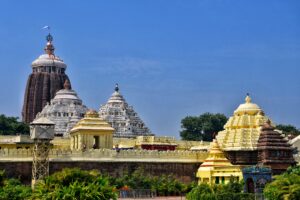
The early medieval period of Indian history was characterized, among other things, formation of regional polities and an appropriation of regional deities and cults into the dominant Hindu pantheon. The nature of these interactions was not always one of confrontation, but one of confluence and integration. One such classic example is the integration of the Nilamadhava deity worshipped by the tribal savara king into the Vaishnava pantheon as lord Jagannatha. Additionally, temple-building after the 12th century CE assumed a completely different significance- territories started to be expressed with reference to its hegemonic temples. The grand temples of Puri, Thanjavur, Tirupati, Lingaraja, Madurai and Pandharpur stand witness to this new significance. In other words, this period saw the development of India’s sacred geographies, as is well documented in the Skanda Purana. The Skanda Purana remarkably draws out the relationship between pilgrim centres and territories, giving the impression that a territory is supposed to be identified with its pilgrim centre.
The construction of the temple of Puri has traditionally been attributed to the Ganga king Anangabhima of the same Ganga dynasty. According to the Skanda Purana and several other such texts, the deity Nilamadhava was originally worshipped secretly in a dense forest by Vishvavasu, a tribal savara chief. When the mythical king Indradyumna came to know about this deity, he sent Vidyapati, a Barhmin priest to locate Nilamadhava. Despite failing initially, he married Vishvavasu’s daughter, and managed to convince his father-in-law to take him blindfolded to the cave where Nilamadhava was worshipped. Vidyapati cunningly marked the path to the cave with mustard seeds so that the trail would later be followed by king Indradyumna. However, when the king arrived at the cave, the deity had disappeared. He undertook s fast unto death in Nilachala unless he secures one darshan of the deity. Having received a celestial voice, the king performed an Ashvamedha sacrifice and built the magnificent Vishnu temple at Puri. In his sleep, he received the vision of Jagannatha, which was supposed to be carved out of the wood of a divine fragrant tree found on the coasts of Puri. In accordance to that, Jagannatha, Balabhadra or Balaram, and Subhadra were carved out by Vishnu himself, disguised as a carpenter, and installed as deities in the Vaishnava temple of Puri.

The grand temple is located on the Nilachal Hill. Although now a bustling city, the Skanda Purana describes the hill to be in the middle of a forest along the seashore. Local wisdom suggests that over the last eight centuries, the sea line has receded by over a kilometre. The temple is made of khondalite unlike other Odia temples, that are primarily made of sandstones. The temple follows Kalinga architecture, an Odia derivative of the Nagara style of architecture. Initially consisting of the garbhagriha (sanctum sanctorum) and mandapa (assembly hall), the natmandira (dance hall) and bhogashala (offering hall) were added later in the fifteenth century. Within the temple complex, the Narasimha shrine situated at the south of the main Jagannatha temple, and the Lakshmi temple in the north-west is believed to be the original shrine. The south-eastern quarter houses the kitchen, where, even today, the food is prepared from traditional locally-sourced ingredients, and prepared in accordance with the prescriptions of the scriptures. The Anandabazar is located in the north-eastern quarter, from where the mahaprasad is sold. Despite its grandeur compared to the temple to other temples of Odisha based on the Kalinga form of architecture, the Jagannatha temple does not have any other distinctive feature or innovation that makes it stand out from the Brahmeshvara or Lingaraja. Other than the imposing height of the temple and a different building material, the Puri temple does not feature any architecturally superior feature.
Coming to the historical significance of the deity, it is quite evident from the legends describing its origin and the deity’s aniconic features that Nilamadhava had tribal origins. The name of the deity itself changed from Nilamadhava (highlighting Vaishnava affiliation) to Purushottam (the Supreme Being), and finally to Jagannatha (Lord of the World) highlighting the processes of integration, influence and consolidation of realms that underwent in the wider political domains. Anangabhima claimed royal descent from Rudra-Shiva, which ensured the integration of the dominant Durga Viraja cult of Jajpur and Rudra Shiva cult of Bhubaneswar into the Ganga ruler’s central Jagannatha cult, through which the Ganga monarch could project his ritual territorial claim over these regions. The decline of Somavamshis and Rajendra Chola’s conquests enabled the Gangas to consolidate their domains in Odisha and Andhra. It was under the rule of Anantavarman Chodaganga that the temple assumed prime importance. Interestingly, Chodaganga was a Shaivite himself, but the fact that he chose to build a Vaishnava temple is remarkable. It is believed that this was in retaliation to Kulottunga I of the Vengi Chalukya lineage assuming the Chola throne. The Cholas were known to be patrons of the Shaivite deities. Also, the auspicious deity of Jagannatha was declared to be a rashtra devata who ruled the kingdom of Kalinga himself, the Ganga monarch being a mere deputy, representative and prime servitor of the lord. Therefore, disobeying the earthly representative of the monarch amounted to treason against the Jagannatha. Thus, the relationship between the monarch and the deity was reworked in order to legitimize ritual Ganga sovereignty over the kingdom of Kalinga, and establish Jagannatha cult as the central supreme cult of Odisha, a legacy which is still in practice.
Sharanyo Basu
Sharanyo Basu is an undergraduate student of History at Presidency University, Kolkata. He is a history enthusiast with interests in social and cultural history, literature and films, and histories of interactions, conflicts and accomodations.

